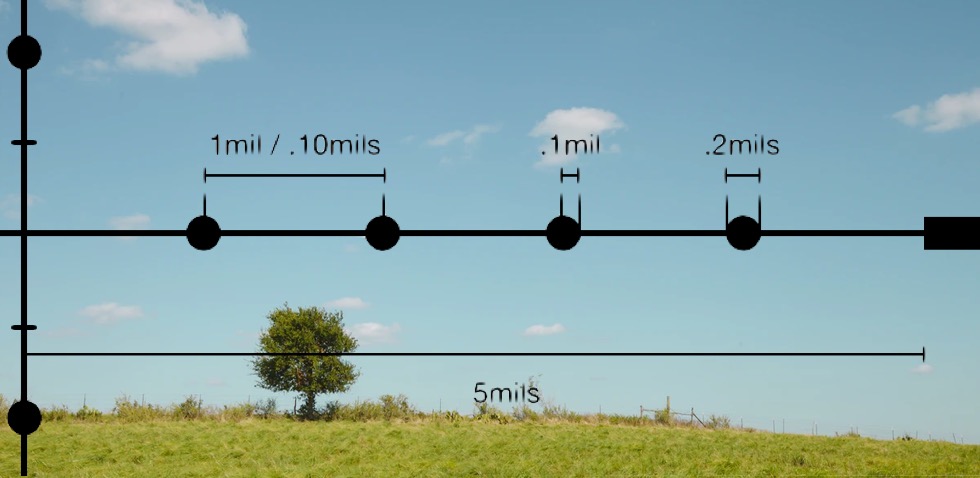The modern precision rifle has come a long way in recent years, even more so amongst civilians who participate in long range and extreme long range shooting events. These advanced rifle systems are often built around top class military sniper rifles, with many similar features. One of these features is the tactical rifle scope, which has become the preferred choice amongst the majority of precision rifle owners. The tactical rifle scope can do many weird and wonderful things when compared to a standard hunting scope, one of which is accurately estimating range from the firing position to your target, using the scope’s mil-dot (or similar) reticle. It is unfortunate though that I have come to notice over the years than many shooters don’t use this feature, even when their scope is capable of doing so. For this reason, our aim today is to discuss methods and techniques of how to estimate range using the mil-dot reticle.
Range estimation by use of a scope’s reticle is achieved by placing your Mil-dots (or hash-marked ranging reticle) over an object, and counting the amount of Mils that are covered from the object’s edge to edge. A simple calculation known as the Mil-dot relation formula is then used to determine an accurate distance to that object. In order to use the Mil-dot formula effectively, you must know the following three things:
- The height or width of the object or target.
- The dimensions of your scope’s reticle.
- How to do basic maths (or have a calculator at hand).
Short of a laser rangefinder, there is no more accurate range estimation device at your disposal, and with practice, range estimation can become a quick and accurate method of determining the distance to your target. As distance grows, knowing the range to your target becomes increasingly important, especially when accurate shot placement is vital. An error of only 25 meters when judging distance can place your bullet anywhere from 10cm (4-inches) to 80cm (32-inches) off your aiming marker, and sometimes even more. For this reason, knowing how to properly judge the distance to your target without relying on battery powered electronics is highly recommended.
The Mil-Dot Relation Formula
The mil-dot relation formula was originally used on military scopes fitted with mil-dot ranging reticles. I used one on my military issue .338 Lapua Magnum, fitted with a Schmidt & Bender 5-25×56 PM II riflescope. In fact, this was where I first learned how to judge distance using the scope’s reticle. Most of my scopes that I own today however do not have mil-dot markings, but rather house a finer hash-marked ranging reticle. The only difference here is the size of the dots versus the reticle’s hash-markings; the math is still the same, but the key is to understand the dimensions of the reticle in your scope.

Reticle dimensions can be found either in your scope’s manual, or on the manufacturers website. The reticle dimensions to the Vortex Viper PST EBR-7C reticle for example, one of the scopes which I use most often, can be found by clicking here.
Once your reticle dimensions are known, along with your target size which we will discuss shortly, the following calculation can be used to determine the distance to your target.
MRAD Reticle Formula
- METRIC CALCULATION: Known Size of Object (mm) / Mils Covered = Distance (meters)
- IMPERIAL CALCULATION: [Known Size of Object (inches) x 27.77] / Mils Covered = Distance (yards)
MOA Reticle Formula
- IMPERIAL CALCULATION: [Known Size of Object (inches) x 95.5] / MOA Covered = Distance (yards)
Tip: in some cases you may wish to known the size of an object which you are observing, particularly when hunting. In this case, you can reverse the formula to give you the size of the object, but you first need to know the distance to your target. To do this, determine the distance to your target using a laser rangefinder, and then multiply this by the mil-dots covered to give you the target’s size.
Let’s Judge Distance
We are going to run through a quick example to put the mil-dot relation formula into perspective for you.
Tip: when using the formula, I always advise using two or three measurements on your target (if possible) to produce the most accurate result.
I have taken screen shots of target sizes from a long range shooting simulation – Shooterready.com – to help demonstrate how to determine distance to your target using your scope.

We can see here that the target height is 76cm, and this covers 1.5 mil-dots in our scope.
760mm / 1.5 = 506 meters.

Now let’s judge the distance once more, but this time using the target’s width.
The target width is 46cm, covering 0.9 mil-dots in our scope.
460mm / 0.9 = 511 meters.
We have used the mil-dot relation formula for both target height and target width above to give us an average distance of 509 meters – good work. When sat behind a real rifle, consider the following tips when judging distance to your target:
- When using Mil-dots or MOA to determine distance, make sure that the object you are measuring is facing you directly. It must not be at an oblique angle, otherwise this will result in a false reading.
- As we mentioned above, try not to rely on just one measurement. Use the Mil-dot formula two or more times, using different measurements and then calculating an average, as this will verify that your reading was accurate and prevent human error.
- It is also highly important to be very precise about the target dimensions and how many Mils you make out the target to be. Rounding up or down is not an option, and the reticle must be aimed just as steadily and as well supported as if you were taking a shot at a target. If you had been .1mil out in the width measurement above, you would have produced a shot error of around 80cm – a complete miss on this target.
How to Determine Target Size
Determining the size of the target or object which you intend on judging distance to can be an easy task, but only if you put in the required work beforehand. This means that some planning and preparation is required before hitting the range, and my advice is to record any and all information that you may need in a field data book.
A field data book is one of the most important tools that a long range shooter can carry, and can be otherwise known as a DOPE (Data Obtained from Previous Engagements) book. This durable, weatherproof book holds all of the shooter’s adjustments and calculations required to accurately engage targets at long distances, including measurements of potential targets or objects that may be used when judging distance.
Data to be recorded in your field book may include:

- Rifle, ammunition and scope performance/ specifications
- DOPE or ballistics charts
- Density altitude charts
- Jump angle alterations
- Cartridge performance and load data
- Barrel and suppressor logs
- Shooting calculations and formulas
- Conversion charts
- Target and object dimensions
- Methods of determining wind speeds
- Poor shooting checklist
- Any other information that you may need to reference later on
My very own field data book has records of many potential target and object sizes, from likely enemy weapon and vehicle dimensions, to steel gong dimensions which I most commonly engage during training, to common sizes of various animals which I may encounter during a planned hunt.
These dimensions are often best found through taking physical measurements of as many relevant objects as you can, or through online research. Wikipedia is a great source of information, although the website only uses data from reliable secondary sources, so always verify the measurements with further online research.
Conclusion
Estimating range using your riflescope is a valuable skill to have, but it requires practice; remember that old saying – practice makes perfect.
It is recommended to use a high quality laser rangefinder where possible, as this will provide you with the most accurate distance to your target. However, as we all know, electronics can fail and it is therefore always best to have a Plan B. In this case, being able to accurately judge distance using your scope’s modern reticle.
Keep a list of pertinent object data in a waterproof field book for easy reference when needed, and try to include training using the mil-dot relation formula each time you head out to the range. A good way to do this is to place or scatter your targets at random unknown distances, and then judge distance before each shot.
And finally, don’t forget to use multiple measurements when using a reticle to judge distance, and be extremely precise about target dimensions, as rounding up will cause too much error.


7 thoughts on “How to Estimate Range with the Mil-Dot Reticle”
What power do you use with a 6×24 scope?….lowest, mid or 24x
Thanks for your comment. Assuming you mean a 6-24x… it really depends. If you have a first focal optic then you can use any power, however this is not the case with a second focal optic. You would need to refer to your user manual or do a Google search based on your scope brand and model. It is common for manufacturers to make measurements valid at the maximum power, which would in your case be 24x. It certainly won’t be on the lower end, the reticle will shrink too much.
Matt, thank you for sharing; I can now refer to this brief article when training in long-range shooting.
Thanks for the handy guide.
i want to know same quewif we chang power or magnification then it comes with difrent measurements in mikrad reticle.. using Hawke vantage 16 by 50